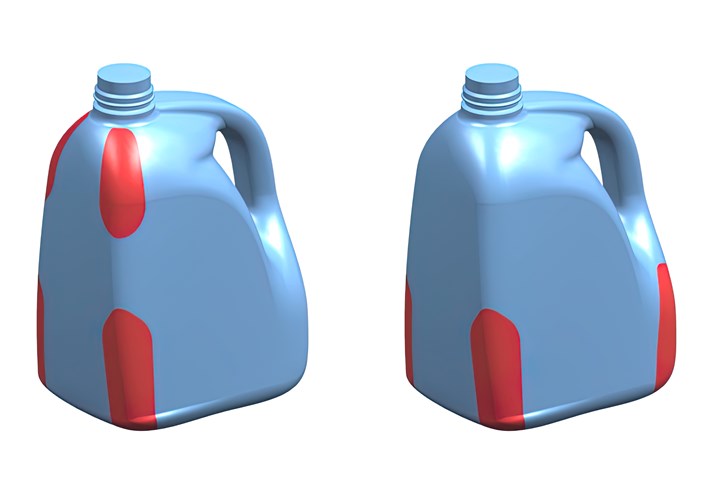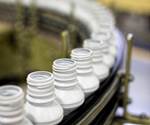
Graham’s patented AccuStrength technology adds vertical ribs of material at selected locations on the parison. The ribs can be continuous or intermittent. Handleware and other non-round containers—especially larger sizes—are the main targets.
Parison programming is a universal tool in extrusion blow molding for selectively thickening and thinning a container wall as the parison is extruded in order to optimize material distribution and achieve the lightest overall weight that satisfies structural requirements such as topload strength and drop tests. Parison programming allows profiling the parison in a sequence of horizontal bands of varying thickness.

Conventional parison programming adds extra material where needed in horizontal bands around the bottle.
What if parison programming were turned on its side? That is approximately what global bottle maker Graham Packaging has achieved with its newly patented AccuStrength technology. Used together with conventional “horizontal” parison programming, AccuStrength adds extra material in vertical “stripes” at selected locations on the container. The vertical bands or ribs can be started and stopped according to electronic programming. The additional resin is added to the parison just before it exits the extrusion die head. This is accomplished with “bolt-on” additional equipment that can be retrofitted to Graham’s existing machines.

Graham’s AccuStrength adds reinforcing material in vertical bands or ribs as the parison is extruded.
New Lightweighting Potential
According to Michael Milazzo, Graham’s senior director of engineering, AccuStrength has been in development since 2015 and was patented in 2020. Graham began testing the technology with selected customers this year.
AccuStrength is designed for Graham’s single-parison wheel machines, and for polyolefins such as HDPE and PP. Graham is targeting handleware and other rectangular or non-round containers. The technology can be applied to containers from 1 fl oz to 10 gal, though, as Milazzo notes, “The larger the container, the more benefit can be realized. Lightweighting up 15% is possible; up to around 11% weight savings have been seen in gallon containers.”
“With just a little bit of added plastic in the right places, we can solve a pretty big issue.”
“We see it as improving bottle performance, cost and sustainability,” says Craig Ward, v.p. of sales in Graham’s home care and industrial business unit. He notes that the home-care market is likely to see the first commercial launch of AccuStrength.
Adds Milazzo, “AccuStrength addresses denting issues, such as from backpressure on a conveyor or when a bottle is dropped into a case. With just a little bit of added plastic in the right places, we can solve a pretty big issue.”
“We’re just scratching the surface with this new technology,” notes Ward. Additional possibilities are using different colors for the reinforcing ribs, or possibly including fillers or reinforcements for extra strength with minimal added material.
Related Content
-
Pregis Performance Flexibles: In the ‘Wow’ Business
Pregis went big and bold with investment in a brand-new, state-of-the-art plant and spent big on expanding an existing facility. High-tech lines, well-known leadership and a commitment to sustainability are bringing the “wow” factor to blown film.
-
US Merchants Makes its Mark in Injection Molding
In less than a decade in injection molding, US Merchants has acquired hundreds of machines spread across facilities in California, Texas, Virginia and Arizona, with even more growth coming.
-
Medical Molder, Moldmaker Embraces Continuous Improvement
True to the adjective in its name, Dynamic Group has been characterized by constant change, activity and progress over its nearly five decades as a medical molder and moldmaker.
















